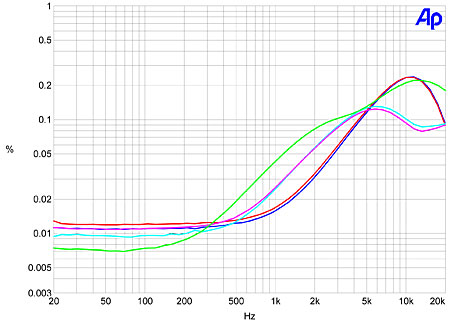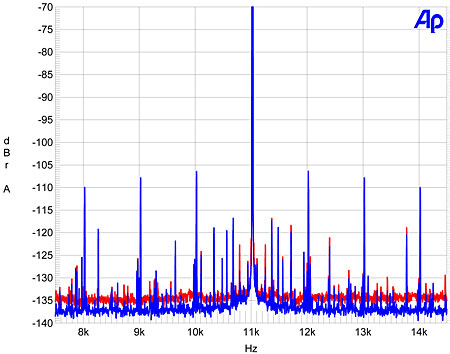| Columns Retired Columns & Blogs |
Bel Canto e.One S300iu integrated amplifier Measurements
Sidebar 3: Measurements
As I usually do with amplifiers, I preconditioned the Bel Canto e.One S300iu by running both channels at one-third the maximum power into 8 ohms for one hour. Thermally, this maximally stresses an amplifier with a class-B or -AB output stage. But with its class-D output stage, the Bel Canto hardly got warm.
I measured the S300iu using Audio Precision's top-model SYS2722 system (see www.ap.com) for most of the tests, with the obsolete AP System One bringing up the rear. The S300iu's maximum gain into 8 ohms was 46.5dB, which is a little higher than usual for an integrated amplifier. Measured at the amplifier's preamp output jacks, the maximum voltage gain was basically to specification at 19.6dB, while the unity-gain setting of the volume control was "80" out of a possible "100." The volume control operated in accurate 0.5dB steps. The S300iu's input impedance was 11.5k ohms across the audioband, and the amplifier preserved absolute polarity; ie, it was non-inverting. The preamplifier section also preserved absolute polarity, and its output impedance was a consistent 100 ohms across the band, significantly but usefully lower than the specified 500 ohms.
The amplifier's output impedance, measured at the speaker jacks, was 0.2 ohm at low and middle frequencies, dropping to 0.04 ohm at 20kHz. The Bel Canto's frequency response was flat within the audioband, but its top-octave behavior depended on the load impedance (fig.1), presumably due to the interaction between the load and the amplifier's low-pass output filter. (Amplifiers with a switching or class-D output stage produce a high level of ultrasonic noise that needs to be reduced if it is not to be reradiated by the speaker cables.) Peculiarly, the response into our standard simulated loudspeaker (fig.1, yellow trace) was lower than into an 8 ohm resistive load (red and blue traces), despite this load exceeding 8 ohms at some frequencies. Perhaps it is relevant that the other channel was driving a 2 ohm resistor when I took this measurement, which means that there might be some cross-modulation when the two channels are handling very different signals, though I admit this is an unlikely event.

Fig.1 Bel Canto S300iu, frequency response at 2.83V into: simulated loudspeaker load (yellow), 8 ohms (left channel blue, right red), 4 ohms (left cyan, right magenta), 2 ohms (green). (0.25dB/vertical div.)
For all the remaining amplifier tests, I used an Audio Precision AUX-0025 Switching Amplifier Measurement Filter between the test load and the test systems. This is because, even with its own low-pass filter, a switching amplifier still puts out a high level of ultrasonic noise that, without further filtering, will drive the input of the test system into slew-rate limiting. For example, without passing an audio signal, the Bel Canto S300iu put out 1.2V RMS of ultrasonic noise with a center frequency of approximately 350kHz. This noise compromises the amplifier's unweighted, wideband signal/noise ratio (ref. 2.83V into 8 ohms) to just 8dB! Restricting the measurement bandwidth to the audioband improved the S/N ratio to a more respectable 62.7dB. (The input was shorted, but the volume control was set to its maximum for this measurement.) Channel separation (not shown) was excellent, at better than 100dB below 800Hz. The amplifier's reproduction of a 10kHz squarewave was respectable (fig.2), though with a single critically damped cycle of ringing evident on the leading edges. (This doesn't appear to be due to the Audio Precision low-pass filter.)

Fig.2 Bel Canto S300iu, small-signal 10kHz squarewave into 8 ohms. Measured with Audio Precision passive LP filter.
Fig.3 plots the percentage of THD+noise in the amplifier's output against output power into 8 and 4 ohms. (The S300iu is not rated into 2 ohms.) Surprisingly, the amplifier didn't meet its specified maximum output power into either load. Defining clipping as when the THD+N reached 1%, the S300iu clipped at 105W into 8 ohms and 202W into 4 ohms (both powers approximately 20dBW). It did meet its rated power, 150W into 8 ohms (21.75dBW), at 11% THD.

Fig.3 Bel Canto S300iu, distortion (%) vs 1kHz continuous output power into (from bottom to top at 100W): 4, 8 ohms. Measured with AP passive LPF.
Fig.4 shows how the percentage of THD+N in the Bel Canto's output varies with both frequency and load impedance. (The graph ends at 20kHz because of the increasing effect of the AP low-pass filter on the measured percentage above 10kHz or so.) It is hard to discern a pattern in this graph. The blue and red traces show the behavior of the left and right channels, respectively, into 8 ohms. Very low at low frequencies, the distortion rises by an order of magnitude in the top two audio octaves. Into 4 ohms (cyan and magenta traces), the THD+N at low frequencies and in the top two octaves is a little lower than into 8 ohms, but is higher between 500Hz and 5kHz. Unusually, into 2 ohms (green trace), the THD+N is even lower at low frequencies than it is into higher impedances.

Fig.4 Bel Canto S300iu, THD+N (%) vs frequency at 10V into: 8 ohms (left channel blue, right red), 4 ohms (left cyan, right magenta), 2 ohms (green). Measured with AP passive LPF.
To some extent, of course, it is the spectrum of the distortion that matters, not its absolute level. At moderate power into 8 ohms, the Bel Canto produced predominantly third-harmonic distortion (fig.5), which will be subjectively benign. Yes, higher-order spuriae can be seen in the spectrum (fig.6), but these are all below –90dB. However, at the same output voltage into 4 ohms, the picture changes completely (fig.7). While the measured THD percentage has slightly more than doubled, the third harmonic has almost disappeared and sharp spikes bracket the waveform's zero-crossing points, these equivalent to high-order harmonics (fig.8), which will be subjectively more offensive. Only at low frequencies did the Bel Canto S300iu behave like a traditional amplifier, even at high powers into 4 ohms (fig.9).

Fig.5 Bel Canto S300iu, 1kHz waveform at 12.5W into 8 ohms (top), 0.019% THD+N; distortion and noise waveform with fundamental notched out (bottom, not to scale). Measured with AP passive LPF.

Fig.6 Bel Canto S300iu, 1kHz waveform at 24.2W into 4 ohms (top), 0.0265% THD+N; distortion and noise waveform with fundamental notched out (bottom, not to scale). Measured with AP passive LPF.

Fig.7 Bel Canto S300iu, spectrum of 1kHz sinewave, DC–1kHz, at 12.5W into 8 ohms (linear frequency scale; left channel blue, right red). Measured with AP passive LPF.

Fig.8 Bel Canto S300iu, spectrum of 1kHz sinewave, DC–1kHz, at 24.2W into 4 ohms (linear frequency scale; left channel blue, right red). Measured with AP passive LPF.

Fig.9 Bel Canto S300iu, spectrum of 50Hz sinewave, DC–1kHz, at 140W into 4 ohms (linear frequency scale; left channel blue, right red). Measured with AP passive LPF.
The decrease in linearity in the top octaves gives rise to a disappointing result with the high-power, high-frequency intermodulation test. While the second-order component at 1kHz is respectably low, there are many higher-order components visible in the top octaves (fig.10).

Fig.10 Bel Canto S300iu, HF intermodulation spectrum, DC–24kHz, 19+20kHz at 40W peak into 4 ohms (linear frequency scale; left channel blue, right red). Measured with AP passive LPF.
Turning to the S300iu's USB input, I tested this using my Apple G4 PowerBook as source and analyzing the Bel Canto's behavior at its preamplifier output jacks. The USB input is compatible with sample rates up to 48kHz, but is limited to 16-bit data. This will not be a practical limitation given the amplifier's target market, I feel. The frequency response via the USB input was flat, so I haven't shown it. But examining the internal DAC's resolution using my traditional technique of sweeping a 1/3-octave bandpass filter from 20kHz to 20Hz while it decoded 16-bit data representing a dithered 1kHz tone at –90dBFS, it was apparent that the DAC didn't reach 16-bit performance. Not only did the peak fail to reach the –90dB line (by a different amount in the two channels), significant amounts of distortion harmonics were present (fig.11). The DAC's linearity plot (fig.12) shows increasing amounts of negative error below –80dBFS; in effect, the DAC is taking energy from the fundamental below this level and pumping it into distortion harmonics. Correlating with this, the waveform of an undithered 1kHz tone at –90.31dBFS, which should show three clearly defined DC levels, is obscured by noise (fig.13).

Fig.11 Bel Canto S300iu, USB input ,1/3-octave spectrum with noise and spuriae of dithered 1kHz tone at –90dBFS with 16-bit data (right channel dashed).

Fig.12 Bel Canto S300iu, USB input, left-channel departure from linearity, 16-bit data (2dB/vertical div.).

Fig.13 Bel Canto S300iu, waveform of undithered 1kHz sinewave at –90.31dBFS, 16-bit data (left channel blue, right red).
Finally, while data streamed to a DAC via a USB connection in theory should be free from word-clock–related jitter, the S300iu's USB input didn't do well when I drove it with the Miller diagnostic tone. Not only were relatively high levels of data-related sideband energy present in the amplifier's analog output, but very strong sidebands could be detected at ±1kHz, ±2kHz, and ±3kHz (fig.14). I don't know what these might be due to, but the Miller Jitter Analyzer calculated the jitter level as a very high 4 nanoseconds peak–peak. As with other amplifiers I have measured in recent years that feature a USB input for digital audio data, the Bel Canto's is best regarded as a convenience feature. It is certainly not suitable for critical listening, in my opinion. For that, you need to use something like Bel Canto's e.One DAC3.

Fig.14 Bel Canto S300iu, USB input, high-resolution jitter spectrum of analog output signal (11.025kHz at –6dBFS, sampled at 44.1kHz with LSB toggled at 229Hz), 16-bit data sourced from Apple TiBook and measured at preamplifier output. Center frequency of trace, 11.025kHz; frequency range, ±3.5kHz (left channel blue, right red).
It is difficult to sum up the e.One S300iu's measured behavior as an amplifier. To some extent, the amplifier will be a sonic chameleon. At low and midrange frequencies, it measured very well into 8 ohms. But at higher frequencies and especially into lower impedances, it misbehaved in a way I would have expected to be audible with some kinds of music. I suspect that it is this higher-frequency misbehavior that WP picked up on when he talked about the amplifier as occasionally having a "bleached" midrange.—John Atkinson
- Log in or register to post comments




































